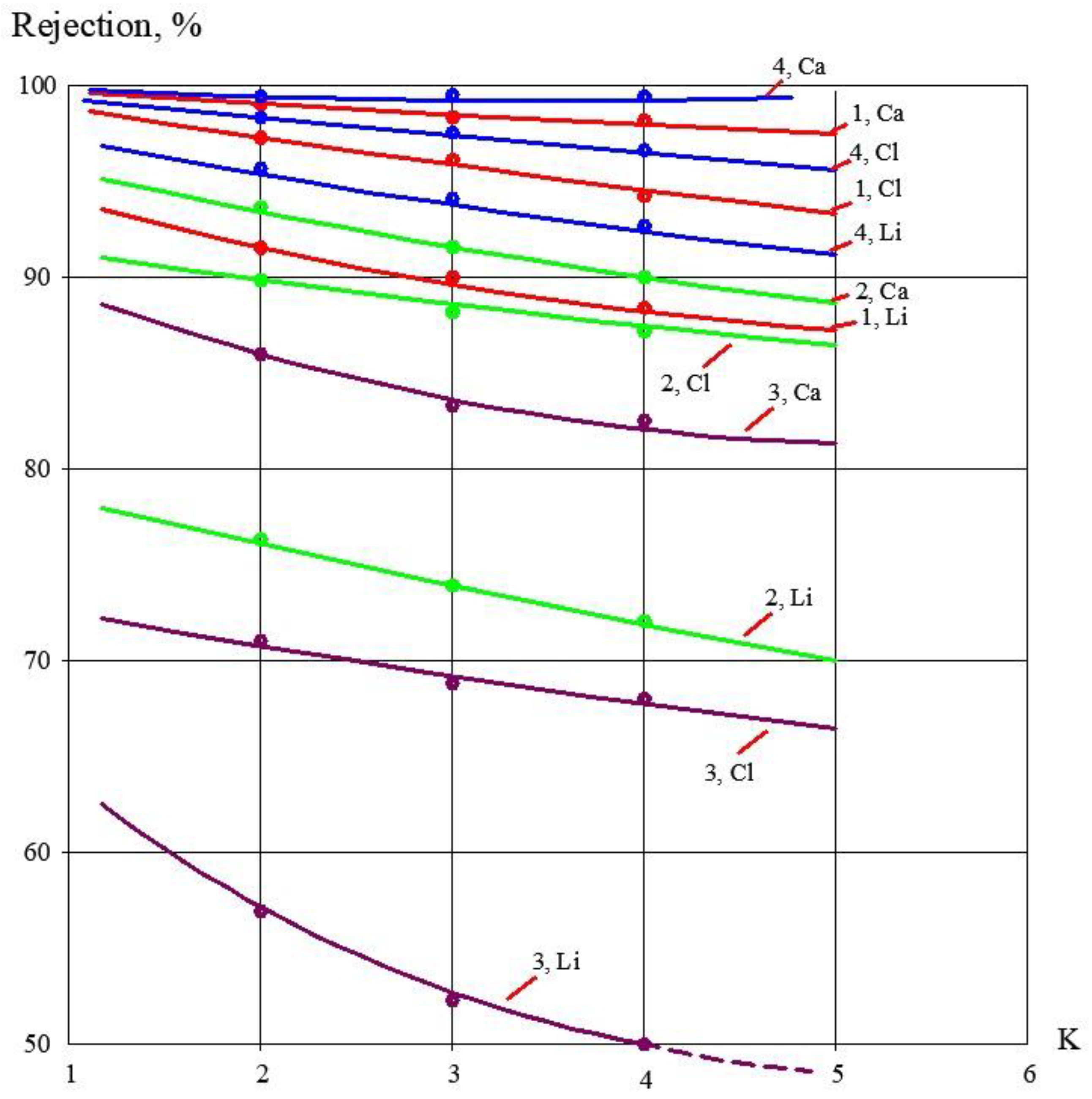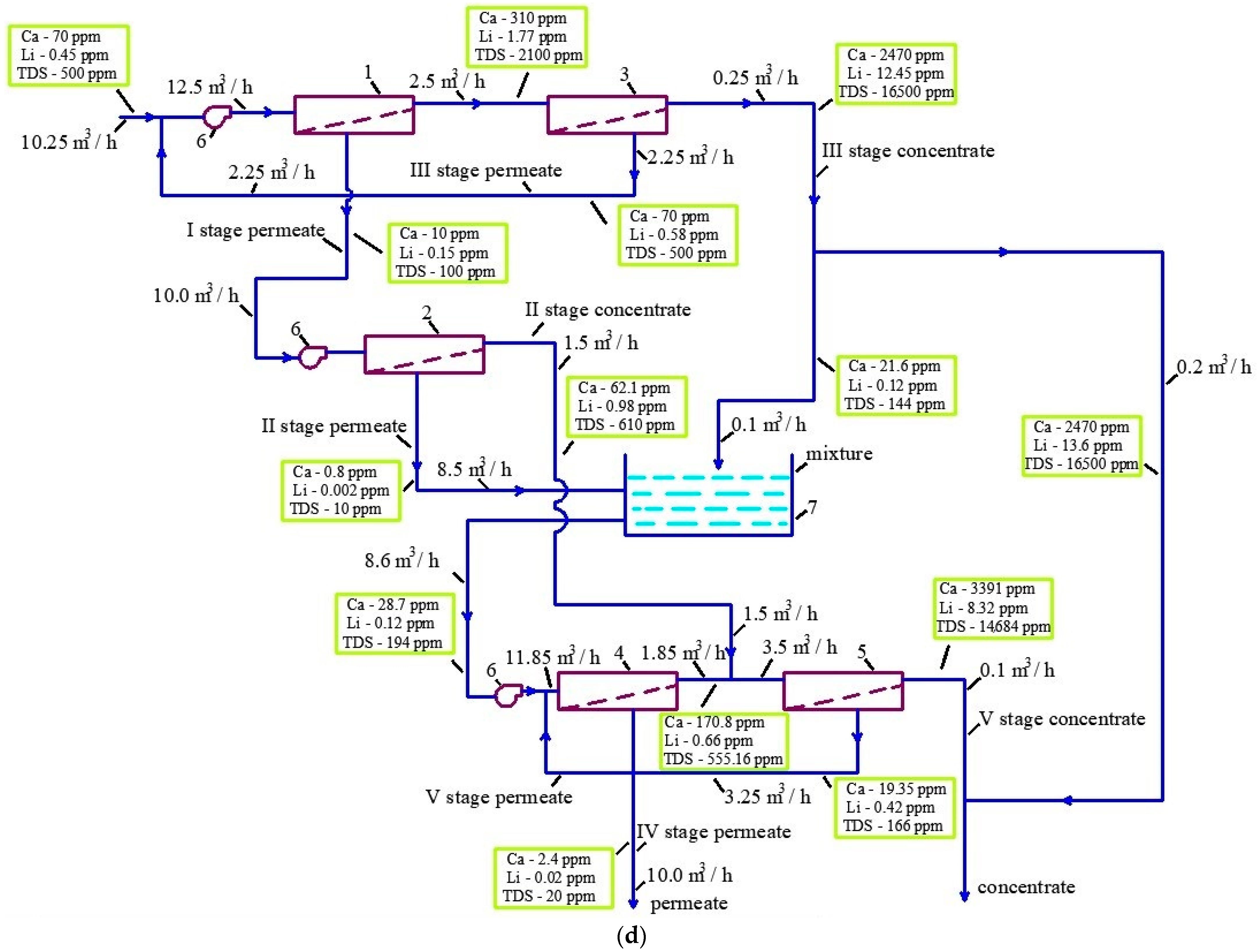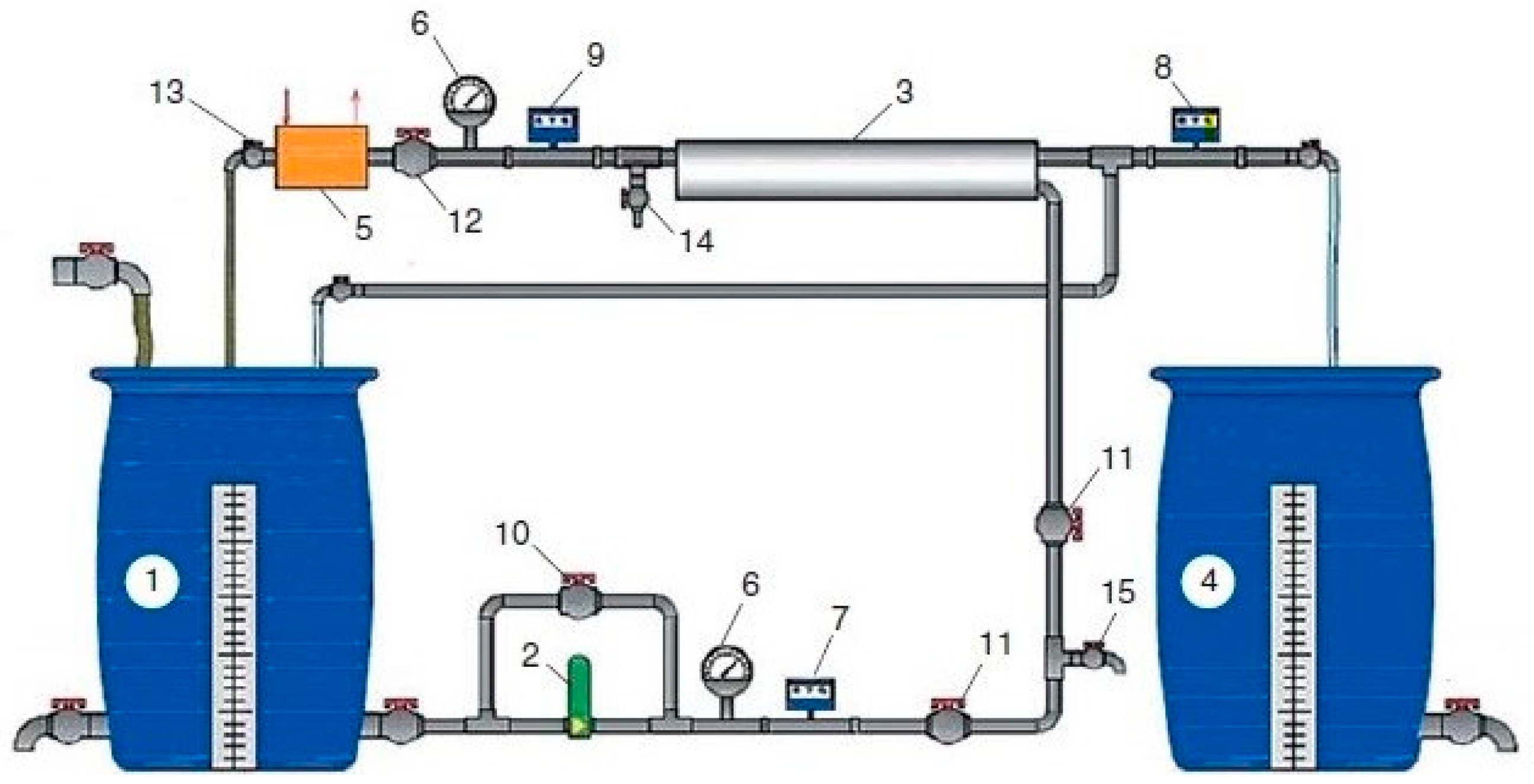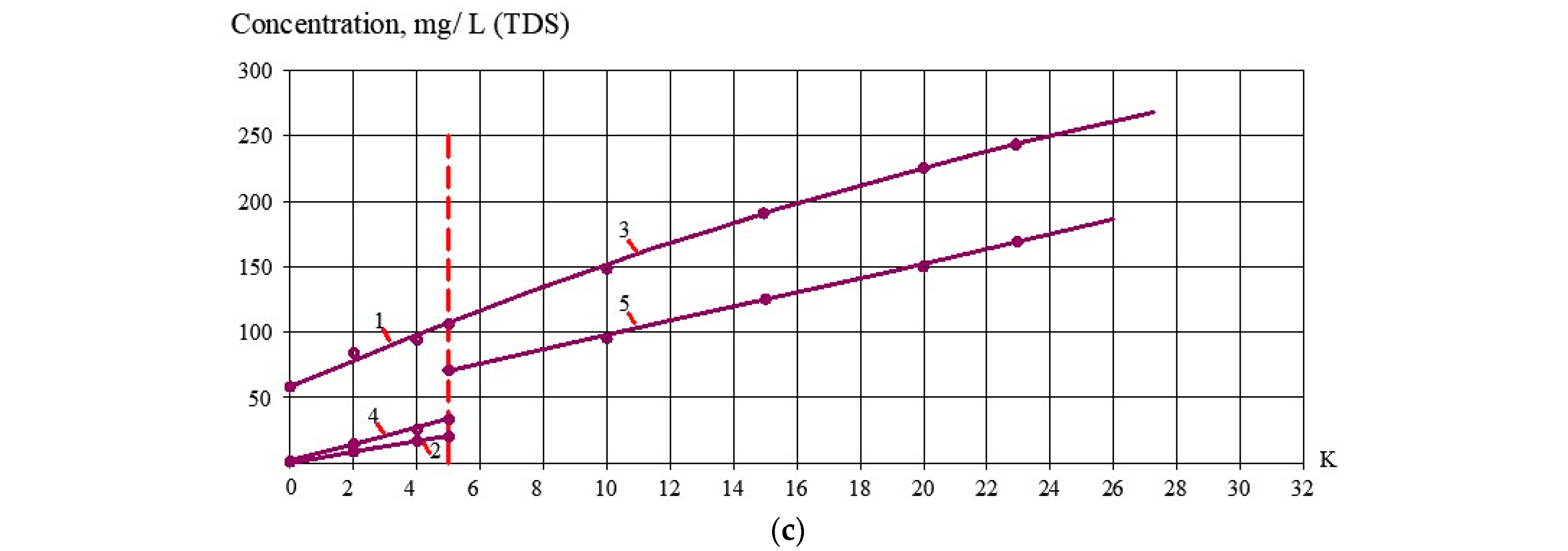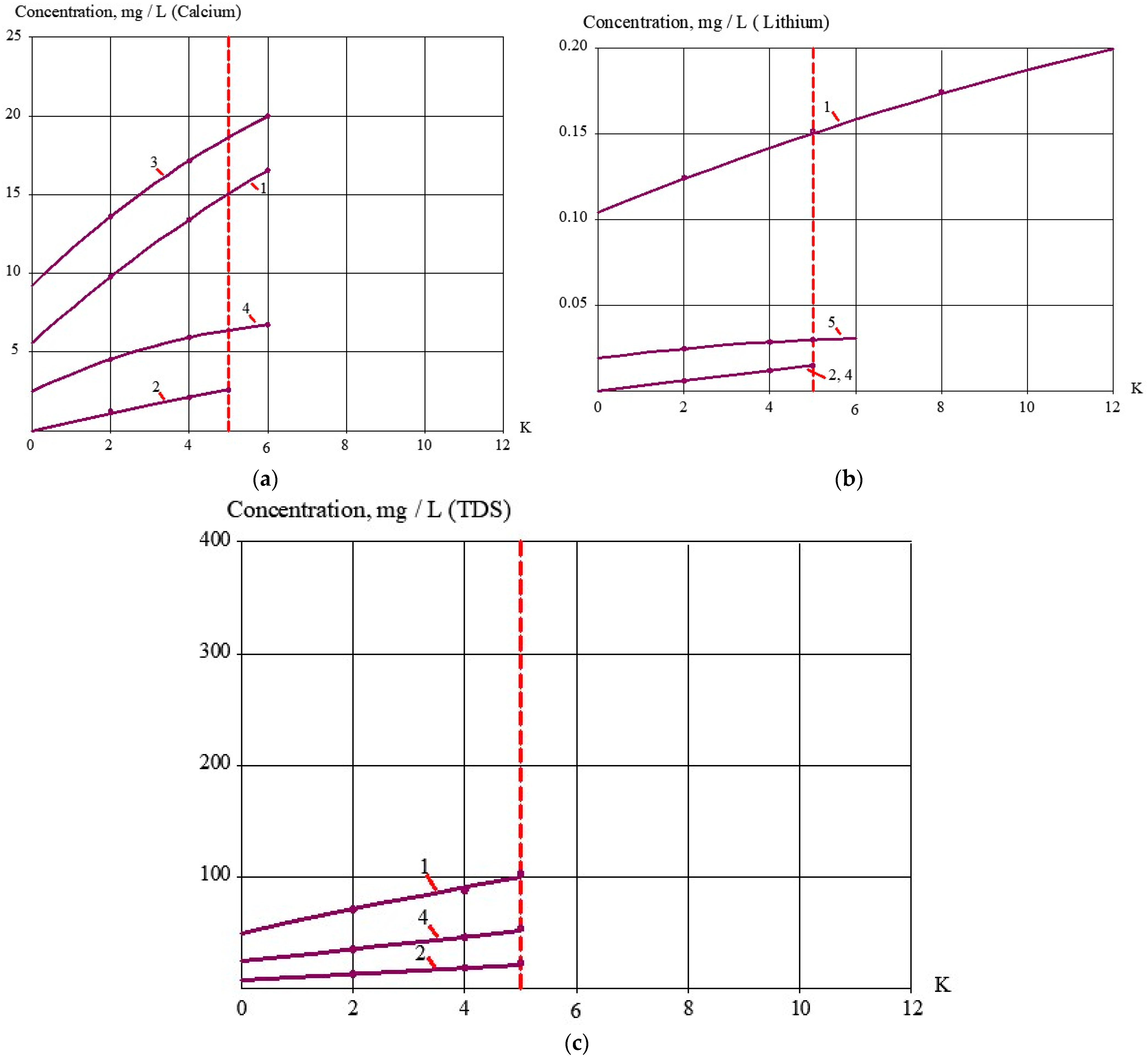1. Introduction: Main Problems of the Use of RO to Achieve Drinking Quality
Reverse osmosis is widely used today to produce quality drinking water from groundwater [
1,
2] and surface water sources [
3,
4]. The territory of the city of Moscow has increased after territories called “New Moscow” have joined. A number of groundwater intakes in the New Moscow region contain above conventionally high concentrations of calcium and iron; excessive amounts of fluoride, ammonia, lithium, strontium; and even boron that exceed World Health Organization (WHO) standards. To remove these impurities and improve drinking water quality, reverse osmosis facilities are currently used [
5,
6,
7]. Despite the high efficiency of reverse osmosis to remove dissolved ionic pollutants, the use of this method for drinking water production seems ineffective. One of the main reasons is that reverse osmosis membranes provide high rejection of both monovalent ions (such as chloride, bicarbonate, and fluoride) and divalent ions (such as sulfate, calcium, and strontium). In the majority of cases, we face the situation when concentrations of ammonia or lithium in groundwater exceed regulation values only by 20–30 percent. In these cases, usually reverse osmosis is used to reduce all substances and total TDS by 95–96 percent. To increase drinking water TDS, the product water (reverse osmosis permeate) is mixed with the feed water. The mixing ratio depends on how much the concentration of the pollutant exceeds the required concentration in drinking water [
5,
7,
8]. This approach can be reasonable only when pollutant concentrations exceed the required values by no more than three to four times. When this ratio value is higher, there is no reason for mixing, as all water should pass through membranes to remove the pollutant. The use of reverse osmosis to produce drinking-quality water from groundwater intakes has certain disadvantages. First, we remove hardness by 96–99 percent and, in a number of cases, should provide water conditioning by adding calcium ions. Second, treatment of groundwater with high hardness limits the recovery value as calcium-sparingly soluble salts are deposited in membrane channels [
9,
10,
11]. In drinking water applications of reverse osmosis facilities, their recovery values significantly affect the cost of the product as well as the amount of operational costs. Concentrate is usually discharged into the sewer, and this increases the total cost of the water produced by the membrane facility. Third, the use of reverse osmosis membranes has a risk of scale formation, and their operation requires increased costs and measures to prevent scale formation [
12,
13].
As mentioned, nanofiltration membranes provide efficient removal of monovalent pollutants [
5,
6,
7,
8], especially in cases where concentrations of these pollutants should be reduced by three times or less [
9,
10,
11]. Application of nanofiltration membranes not only provides efficient removal of monovalent pollutants but also reduces operational costs [
14,
15]. Moreover, it was reported that the application of an additional nanofiltration stage at the exit from a reverse osmosis facility can easily increase the recovery and significantly reduce the total cost of the supplied product water [
1,
2,
6,
7]. These results are attributed to the low-scaling propensities of nanofiltration membrane modules.
Table 1 shows the composition of groundwater from the well in Yakutia and the results of its treatment with different types of membranes [
1,
2].
There are a lot of cases where certain monovalent pollutant concentrations (like lithium) can exceed WHO standards by 20–24 times [
12,
13].
Table 1 shows the groundwater composition in Yakutia. The lithium concentration is 0.48 milligrams per liter. This means that the lithium concentration should be reduced by 24 times to reach drinking water standards.
Table 1 shows the results of the treatment of groundwater using different membranes. Rejection values of different ions depending on the initial volume reduction coefficient K value, based on the already published results [
14,
15], are presented in
Figure 1.
During experimental product conductance, we determined the relationships (dependencies) of concentrations of dissolved impurities on the value of the initial volume reduction coefficient
K. The coefficient
K value is the ratio of the feed water flow rate to the concentrate flow rate,
Qf/
Qc. This value also corresponds to the recovery that is defined as a ratio of permeate flow to feed water flow according to the equation:
As can be seen, even the application of low-pressure BLN membranes does not guarantee efficient removal of lithium at pressures of 10–12 bars and a 70 recovery. High efficiency can be reached using BE high rejection medium pressure membranes. Meanwhile, the calcium concentration of the product water is less than 0.05 mg/L, and the TDS is about 5 ppm. These results are questionable as BE membranes require high pressure and therefore high power costs, and membrane product flux is significantly lower than that of BLN membranes. Additionally, we should mention high scaling rates and low recovery.
A lot of applications with RO are used to reject monovalent pollutants, such as ammonia and lithium [
12,
13]. Drinking water production also requires the reduction of monovalent ions in many cases [
9,
10,
11]. Moreover, membranes are selected only owing to their ability to reject monovalent ions. As a result, when we reduce monovalent ions, we produce deionized water, which is not applicable for drinking. This article proposes a new approach to providing drinking water quality using the developed ion separation techniques based on different rejections of ions. This new technique is used together with other developed concentrate reduction techniques. Principles of concentrate reduction are based on the application of nanofiltration membranes [
16,
17,
18] that are less susceptible to scaling [
14,
15].
Figure 2a shows a typical solution for groundwater treatment: using high rejection membranes with low values of recovery. This approach requires costs for chemicals and concentrate disposal [
15,
19,
20].
All drawings presented in
Figure 2 contain flow diagrams with flow and concentration values determined throughout the experiment test runs described below. To improve the situation, a reduction in concentration can be applied.
Figure 2b demonstrates the concentrate reduction technique using a low rejection nanofiltration membrane on the second stage. The second-stage permeate is forwarded to the inlet of the first stage. This approach enables us to reduce concentrate flow by 5–10 times. This flow diagram provides a solution to the concentrate disposal problem. But the scaling problem and high operational costs to escape it are still not solved.
Figure 2c demonstrates the solution to improving drinking water quality using low-pressure and low-rejection nanofiltration membranes. As discussed, the application of low rejection membranes reduces calcium carbonate scaling [
15,
19]. Nanofiltration membranes also provide higher flux at lower pressure values [
21,
22,
23]. Thus, the use of the double-stage nanofiltration membranes provides the same quality of product water. Due to the high product flow rate, the double-stage scheme can use fewer membrane modules than the single-stage scheme. And the lower scaling propensities of nanofiltration membranes make this approach economically reasonable [
20,
24,
25,
26]. Concentrate flow reduction in this scheme is implemented using the additional nanofiltration stage to treat the first-stage concentrate. The second-stage concentrate is forwarded at the entrance to the first stage. The only concern is the low hardness and low TDS of the product water, which can require additional costs for conditioning. In the present article a new technique is studied: the possibility of increasing the TDS and hardness of product water using ion separation with nanofiltration membranes [
1,
15,
27].
Figure 2a demonstrates a conventional approach to treating groundwater to reduce different dissolved impurities such as ammonia, strontium, fluoride, lithium, aluminum, titanium, nitrate, etc. Despite high rejection of impurities, this approach has two main, well-recognized disadvantages: scaling hazards and low recovery, which are attributed to high calcium content and an increase in scaling rate with an increase in recovery. There is another disadvantage of high rejection that is attributed to low TDS of product water, low hardness, and low fluoride: the lack of the physiologically necessary elements. The technological scheme shown in the
Figure 2a is further named Option 1.
Figure 2b demonstrates the application of a new approach to reduce the concentrate of RO membrane facilities (Option 2). Concentrate is reduced due to the use of nanofiltration membranes with low salt rejection [
2,
27]. Low rejection of membranes ensures low scaling rates in nanofiltration membrane modules [
2,
15]. The permeate of the nanofiltration module does not correspond to drinking water quality requirements and, in its composition, approaches the feed water. Nanofiltration permeate is returned back to the inlet for the reverse osmosis membrane stage.
To avoid scaling problems and operational cost increases, we can use a double-stage membrane treatment scheme (
Figure 2c). Two nanofiltration membrane stages are used to achieve the required lithium reduction (
Table 1). The advantage of nanofiltration membrane applications is attributed to their lower scaling propensities compared to RO membranes. This enables us to exclude antiscalant dosing and reduce cleaning agent consumption [
2].
To overcome the disadvantage associated with low permeate TDS after lithium removal, a new method is developed that consists of the separation of monovalent and divalent ions. The first membrane stage uses membranes of the 70 NE model (
Figure 2d) that reject only 66–70 percent of lithium or reduce lithium concentration by three times, as shown in
Table 1. Thus, about 30–33 percent of lithium penetrates the product water of the first stage. This permeate enters the second stage, which is tailored by the 90 NE membrane that rejects 80–85 percent of lithium. Thus, the second membrane stage produces permeate with a lithium content reduced by 20–24 times as compared to the feed water. The second-stage permeate also has a low TDS value [
2] and very low calcium content. To reduce concentrate flow, the third stage is furnished with 70 NE membranes, which are used after the first stage. As shown in
Figure 2c,d, the third stage has high recovery and reduces concentrate flow by another five to eight times. As the 70 NE membrane has low rejection ability, the permeate of the third stage, by its quality, approaches the quality of the feed water (
Figure 2d), and therefore it is directed to the entrance to the first stage and mixed with the feed water. Thus, we achieve high recovery values at the level of 0.96–0.97 during groundwater treatment. The use of nanofiltration membranes allows us to change the value of the ratio of monovalent and divalent ions in the concentrate depending on the recovery.
Figure 2d shows concentration values of calcium and lithium in permeate and concentrate at all stages of membrane treatment. Low-rejection nanofiltration membranes have larger pore sizes than reverse osmosis membranes and provide better rejection of divalent (large-sized) ions than smaller-sized monovalent ions (
Table 1). Therefore, calcium ions penetrate less into the product water than lithium ions (
Figure 2d). The third stage reduces the volume of concentrate that contains only 84–90 percent of the lithium that initially entered the first membrane stage. Therefore, calcium concentration in concentrate increases by a greater number of times than lithium concentration.
Figure 2d shows concentration values of calcium, lithium, and TDS in permeate and concentrate predicted using material balance calculations based on the recoveries taken from
Table 1 and
Figure 1. As seen in
Figure 2d, the calcium concentration in the third-stage concentrate increased by 36 times, while the lithium concentration only increased by 25 times. This effect we noticed formed the basis of our development to increase product water calcium content and TDS values, leaving lithium concentration at the same level. We can dilute the concentrate with distilled water and obtain a solution with the required lithium concentration value of 0.02 mg/L. This was achieved by dilution of the part of the third-stage concentrate by the second-stage permeate and further treatment of the mixture with nanofiltration. Considering that the second-stage permeate in its composition was similar to distilled water (
Figure 2d), we mixed one volumetric part of the third-stage concentrate with 16 volumetric parts of the second-stage permeate. After dilution, the Alcuin concentration in the mixture increased by three times, and the TDS value increased by two times higher than in the first-stage permeate. This mixture was treated in the fourth stage using 90 NE nanofiltration membrane, and TDS as well as calcium concentration values increased in the fourth-stage permeate proportionally (
Figure 2d).
To reduce the concentrate flow rate in all Options, a third stage is applied that uses low-rejection nanofiltration membranes. The permeate of this stage, by its quality, approaches the quality of the feed water and is forwarded to the inlet of the first stage (Options 2, 3, and 4). In options 3 and 4, the concentrate of the second stage is also concentrated by its ionic composition close to the feed water and is also mixed with the feed water at the entrance to stage 1 (
Figure 2b,c). In Option 4, we did not direct the second-stage concentrate flow to the entrance of the scheme, as the main goal of this technological approach was to withdraw excessive lithium from the third-stage concentrate. The concentrate of the second stage is further mixed with the concentrate of the fourth stage and enters the fifth stage.
2. Experimental Procedure: Materials and Methods
To perform the experiments, a 25 L sample was delivered. The experiment was aimed at obtaining the main technical parameters that correspond to the scheme shown in
Figure 2d and the performance of test runs to reach the desired concentration ratio K values. Well water with the following composition was tested: calcium (ppm); alkalinity (ppm); lithium (ppm); chlorides (ppm); sulfate (ppm); TDS (ppm). The pH was 7.2.
A test unit flow diagram is shown in
Figure 3. Nanofiltration membrane elements were tailored to 1812 standard with 70 NE and 90 NE membranes (developed by CSM Company, Seoul, Republic of Korea) and supplied by Raifil Company (Moscow, Russia). The test procedure consisted of the circulation of the feed water in the membrane module, the collection of permeate in a separate permeate tank, and the return of concentrate back to the feed water tank.
The volume of the feed water was 25 L. The experimental program consisted of five steps (stages):
In the first stage, feed water was treated using 90 NE membranes to achieve 80 percent recovery;
In the second stage, 90 NE concentrate was further treated with 70 NE membranes to reduce the concentrate value by 5–6 times to reach a concentrate volume of 1 L;
In the third stage, the collected first-stage permeate (18 L) was treated by 70 NE membranes to reach 80–85 percent recovery and the desired value of lithium concentration (0.02 mg/L);
Concentrations of calcium, lithium, and TDS in concentrate and permeate were evaluated throughout all test runs. The final stages of the experimental program included:
In the fourth stage, we mixed the second-stage permeate of 70 NE membranes with the third-stage concentrate obtained using 70 NE membranes in the second stage of the experiment and determined the concentration values of calcium and lithium as well as the TDS value;
In the fifth stage, the mixture was again treated by 70 NE membranes to produce a product of water and concentrate, achieving 80 percent recovery. Membrane spiral wound modules (models 1812-70 NE with nanofiltration membranes and 1812-BLN with reverse osmosis low pressure membranes) were supplied by Toray Advanced Materials Korea Inc. (the manufacturer of CSM Membrane Technologies, Seoul company CSM, Seoul, Republic of Korea). The membrane area in spiral wound elements was equal to 0.5 square meters.
Permeate and concentrate samples were withdrawn from tanks 1 and 2. Calcium, chloride, and lithium concentrations, as well as pH and TDS values, were determined. Calcium and magnesium concentrations were determined by titration. Sulfate ion concentrations were determined using the turbidimetric method. Sodium ion concentrations were evaluated using the atomic adsorption method. Lithium was determined by the atomic-emission analysis method using an atomic adsorption spectrophotometer operated in emission mode. Electric conductivity, TDS, and temperature values were determined using the electrical conductivity meter (model Cond.730, WNW “Inolab-Akvilon”, Moscow, Russia). pH values were determined using the laboratory pH meter HI 2215 (Hanna Instruments, Vohringen, Germany).
In experiments, the authors aimed to demonstrate the possibility of controlling product water quality and increase the TDS and calcium concentrations while leaving the lithium concentration at the same level. This method is described as Option 4 (
Figure 2d). Experiments were performed to demonstrate the values of all parameters (permeate and concentrate) on each membrane stage. The volume of the water sample was 25 L. The chemical composition of the feed water is presented in
Table 1. The main problem that prevents the use of water for drinking purposes is its high lithium content, which exceeds drinking quality standards by 24 times (
Table 1). Treatment of natural water is performed using spiral wound elements of 1812 standard tailored with 70 NE and 90 NE membranes. Membrane 1812 measures 2 inches (4 cm in diameter and 30 cm in length). Membrane elements were loaded into pressure vessels. Each test run simulated the conditions of each membrane stage. Stage 1 (
Figure 2d) used a membrane module with 90 NE membranes. The choice of the 90 NE membrane model is explained by the relatively high rejection value required to reduce lithium concentration by 6–8 times (
Table 1), as the application of 70 NE membranes on both stages cannot ensure a reduction of lithium concentration by 24 times. In the first stage, the recovery value reached 0.8, which corresponds to the initial volume reduction coefficient K value of 5. In the test run, the initial volume of water sample in feed water tank 1 (
Figure 3) was reduced by 5 times, from 25 to 5 L. The permeate volume produced by the module with 90 NE membranes (20 L) was collected in tank 4 (
Figure 3). After that, the membrane module with 90 NE was disconnected, and then the module with 70 NE membrane was attached using thin 6 mm plastic tubes. The small size of the pressure vessel and use of 6 mm plastic tubes connected with John Guest fittings simplify the procedure of attaching tubes. The next test run simulated the third stage (
Figure 2d) when the concentrate flow of the first stage was reduced by 5 times and the coefficient K value was reduced from 5 to 25. During this test run, the volume of concentrate in tank 1 (
Figure 3) was reduced from 5 L to 1 L. The second-stage operation was experimentally demonstrated by the treatment of the collected permeate of the first stage using a 70 NE membrane. The volume of 20 L was reduced by 5 times, leaving 4 L of concentrate. According to Option 4 (
Figure 2d), the second-stage permeate and the third-stage concentrate are mixed and treated in the fourth stage using a 70 NE membrane. At the fourth stage, the volume of the mixture equal to 17 L (16 L of the second-stage permeate plus one liter of the third-stage concentrate) was reduced by 5 times (K = 5). Permeate from the second stage (11.6 L) was collected in tank 4 (
Figure 3). The fifth stage was performed to further reduce the fourth-stage concentrate left in tank 1 (
Figure 3) after the test run using the same 70 NE membrane. Concentrate during the fifth stage of treatment was reduced by 12 times. Permeate from the fifth stage was collected in a separate tank.
Figure 4 shows the dependencies of Ca, Li, and Cl concentrations in concentrate in the first stage and third stage as functions of K.
Figure 5 shows the concentrations of these ions in the product on the second stage as dependencies on K. We used 70 NE membranes on the first stage and 90 NE membranes on the second stage. After we produced permeate in the second stage, we implemented mixing with the concentrate produced in the third stage. After mixing, we get water with a calcium concentration of ppm, a lithium concentration of ppm, and a TDS value of ppm. The results of the treatment of the mixture of the second-stage permeate with the third-stage concentrate are presented in
Figure 6. During the experiment, conductance and product flow rate were constantly measured to detect membrane flux reduction during the feed water concentration increase. Also, calcium concentrations were measured to calculate calcium carbonate growth rates in membrane modules during constant recovery increases. Results of membrane-specific product rate reduction and calcium carbonate scale increase with coefficient K value growth are demonstrated in
Figure 7a,b. Calcium carbonate deposition rates were determined using mass balance techniques described earlier [
2]. The techniques are based on the determination of derivatives of the function of the amount of deposited calcium over time.
4. Discussion
Treatment of feed water with nanofiltration membranes (
Figure 4 and
Figure 5) using two stages of concentrate reduction provides an increase in calcium ion concentration only by 40 times and a 50-fold increase in TDS value despite the 99% recovery.
The second-stage membrane quality provides a reduction of lithium of 27–30 times (96.5–96.7% rejection) to provide permeate quality similar to that achieved by the use of reverse osmosis BE membranes. The mixing of the second-stage permeate and third-stage concentrate provides water with higher TDS and calcium concentration values than the first-stage permeate (Scheme shown in
Figure 2d).
Figure 6 shows the results of the mix-blend treatment with 70 NE membranes. As shown in
Figure 6, the calcium concentration in permeate increased by six times as compared with the second-stage permeate, and the TDS value increased by five times. When the permeate flow value reached 1000 L per hour and concentrate flow value reached 10 L per hour (a 100 times reduction), the concentrate TDS value reached 50 g per liter, which is substantially lower than what Schemes 1–3 shown in
Figure 2a–c can reach.
A comparison of water treatment schemes is performed, and the results are shown in
Table 2. The main operational characteristics of the discussed technological schemes are determined using the data presented in
Figure 7.
To provide an economical comparison of the technological schemes (Options), the authors evaluated the technical and operational parameters of the water treatment plant with a 10 cubic meter per hour capacity. The technical parameters were: number of membrane modules 8040 and membrane replacement costs; recovery; electric power consumption; reagent consumption (antiscalant and cleaning chemicals). Also, the required costs for water conditioning (lime addition to increase hardness) were accounted for, as were the costs to discharge concentrate into the sewer.
The required membrane surface area was evaluated using the average specific membrane product flow rate for each stage, assuming the permeate flow amount produced by each stage during one hour. For Options 3 and 4 (
Figure 2c,d), the average specific flow rate was liters (
Figure 7a) and the flow rate was 10 and 12 cubic meters per hour, respectively. Thus, the membrane area for Options 1 and 2 at the first stage was 650 square meters, and for Options 3 and 4, 280 square meters. Assuming the membrane area in an 8040 standard element is 40 square meters, the number of elements in Option 3 is 17 and in Option 4 23. A similar number of elements is required for stage 3 in Options 3 and 4 as well as for stage 2. The number of elements on stage 4 in Option 4 was calculated similarly to stage 2, assuming that feed water TDS is higher and membrane-specific product flow average value is lower (
Figure 7, curve 4). As is shown in
Table 2, the required number of 8040 membrane elements to achieve the required recovery equal to 0.95 is 17 for Option 3 and 23 for Option 4. In Option 2, this number is higher and equals 20.
The data presented in
Table 2 confirms the efficiency of nanofiltration membranes application in a double-stage scheme to reduce lithium or another monovalent impurity from groundwater. The advantage is demonstrated by the calculation of annual operational costs for Options 1, 2, 3, and 4, shown in
Figure 2. In our calculations, we accepted that the average price of an 8040 standard membrane element is 500 USD, cost of antiscalant and cleaning chemicals (EDTA) is 10,000 USD per ton, cost of lime is 500 USD per ton, cost of one kilowatt of energy is 0.05 USD, and cost of discharge of one cubic meter of concentrate into the sewer is 0.2 USD.
The application of RO membranes causes scaling problems that require antiscalant dosing and cleaning. RO requires a pressure of 16 bars. Nanofiltration membranes require 10–12 bars, thus requiring lower power costs. To evaluate the cleaning costs, we used the developed recommendations [
2] based on the results of research [
15]. Nanofiltration membranes of the 70 NE model exhibit low scaling rates, which allows operators to refrain from antiscalant dosing [
2] and reduce their consumption of cleaning chemicals.
As can be seen in
Table 2, the application of additional ion separation provides better product water quality. Also, a substantial reduction in operational costs can be achieved due to savings in power and reagent consumption (lime, antiscalant, and cleaning chemicals).
